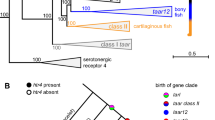Summary
Comparison of DNA sequences of the rat (Rattus norvegicus) olfactory receptor gene family revealed an unusual pattern of nucleotide substitution in the gene region encoding the second extracellular domain (E2) of the protein. In this domain, nonsynonymous nucleotide differences between members of this subfamily that caused a change in amino acid residue polarity were over four times more frequent than nonsynonymous differences that did not cause a polarity change. This nonrandom pattern of nucleotide substitution is evidence of past directional selection favoring diversification of the E2 domain among members of this subfamily. This in turn suggests that E2 may play some important role in the functions unique to each member of the olfactory receptor family, and that it may perhaps be an odorant binding domain.
Similar content being viewed by others
References
Beets MGJ (1978) Odor and stimulant structure. In: Carterette C, Friedman MP (eds) Handbook of perception: vol. VIa, Tasting and smelling. Academic Press, New York, pp 245–255
Buck L, Axel R (1991) A novel multigene family may encode odorant receptors: a molecular basis for odor recognition. Cell 65:175–187
Eisenberg SP, Brewer MT, Verderber E, Heimdal P, Brandhuber BJ, Thompson RC (1991) Interleukin 1 receptor antagonist is a member of the interleukin 1 gene family: evolution of a cytokine control mechanism. Proc Natl Acad Sci USA 88: 5232–5236
Goodman M, Moore GW, Matsuda G (1975) Darwinian evolution in the genealogy of hemoglobin. Nature 253:603–608
Hamm HE, Deretic D, Arendt A, Hargrove PA, Koenig B, Hofmann KP (1988) Site of G protein binding to rhodopsin mapping with synthetic peptides to the a subunit. Science 241:832–835
Hughes AI (1991) Circumsporozoite protein gene of malaria parasites (Plasmodium spp.): evidence for positive selection on immunogenic regions. Genetics 127:345–353
Hughes AL, Nei M (1988) Pattern of nucleotide substitution at major histocompatibility complex class I loci reveals over-dominant selection. Nature 335:167–170
Hughes AL, Nei M (1989) Nucleotide substitution at major histocompatibility complex class II loci: evidence for overdominant selection. Proc Natl Acad Sci USA 86:958–962
Hughes AL, Ota T, Nei M(1990) Positive Darwinian selection promotes charge profile diversity in the antigen-binding cleft of class I major-histocompatibility molecules. Mol Biol Evol 7:515–524
Kimura M, Ohta T (1974) On some principles governing molecular evolution. Proc Natl Acad Sci USA 71:2848–2852
Kobilka BK, Kobilka TS, Daniel K, Regan JW, Caron MG, Lefkowitz RJ (1988) Chimeric α2-β2 R2-adrenergic receptors: delineation of domains involved in effector coupling and ligand binding specificity. Science 240:1310–1316
Lee Y-H, Vacquier V (1992) The divergence of species-specific abalone sperm lysins is promoted by positive Darwinian selection. Biol Bull 182:97–104
Li W-H (1983) Evolution of duplicate genes and pseudogenes. In: Nei M, Koehn RK (eds) Evolution of genes and proteins. Sinauer, Sunderland, MA, pp 14–37
Li W-H (1989) A statistical test of phylogenies estimated from sequence data. Mol Biol Evol 6:424–435
Mollon J (1991) Hue and the heptahelicals. Nature 351:696–697
Nei M, Gojobori T (1986) Simple methods for estimating the numbers of synonymous and nonsynonymous nucleotide substitutions. Mol Biol Evol 3:418–426
Nei M, Jin L (1989) Variances of the average numbers of nucleotide substitutions within and between populations. Mol Biol Evol 6:290–300
O'Dowd BF, Lefkowitz RJ, Caron MG (1989) Structure of the adrenergic and related receptors. Ann Rev Neurosci 12:67–83
Ohno S, Wolf U, Atkin NB (1968) Evolution from fish to mammals by gene duplication. Hereditas 59:169–187
Saitou N, Nei M (1987) The neighbor joining method: a new method for reconstructing phylogenetic trees. Mol Biol Evol 4:406–425
Tinbergen N (1951) The study of instinct. Clarendon Press, Oxford, p 195
Wheeler JW (1977) Properties of compounds uses as chemical signals. In: Miiller-Scwarze D, Mozell MM (eds) Chemical signals in vertebrates. Plenum Press, New York, pp 61–70
Author information
Authors and Affiliations
Additional information
Offprint requests to: A.L. Hughes
Rights and permissions
About this article
Cite this article
Hughes, A.L., Hughes, M.K. Adaptive evolution in the rat olfactory receptor gene family. J Mol Evol 36, 249–254 (1993). https://doi.org/10.1007/BF00160480
Received:
Accepted:
Issue Date:
DOI: https://doi.org/10.1007/BF00160480




